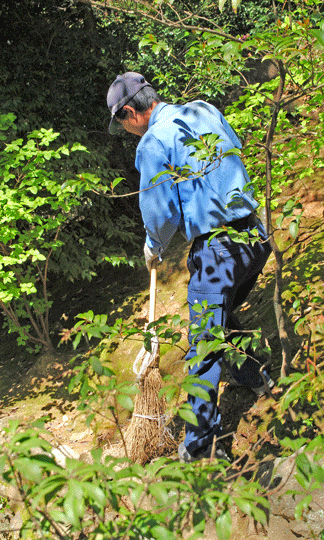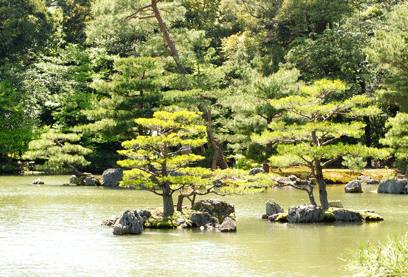There is a temple in Kyoto, Japan, that looks like it is made out of gold. It is. Kind of. Kinkaku-ji has layers of gold leaf on it that make the temple in its picturesque setting a breathtaking sight to behold. There are miniature islands with perfect miniature landscapes scattered around the pond that surrounds the temple. On the top of this shimmering gold temple, boldly stands a phoenix with wings spread in a pose that seems quite determined.


There were gardeners raking the forests of the temple grounds. As we strolled along the paths, I could see glimpses of a person here and a person there sweeping the forest floor and collecting the debris into large cloth like sacks. I was entranced more by the uniqueness of these confusing observations than by the uniqueness of the extravagant pavillion. Why would someone sweep a forest?
As I looked around, I could see a tidiness I had never encountered before in anywhere as densely populated with trees. I recalled what a forest normally looks like with the underbrush cluttered with thick layers of fallen twigs, leaves, and mulch. This forest was like the forest of my OCD dreams; crisp, clean, and still remaining natural looking by not being conformed into rows.
Not all of Japan’s forests are immaculately polished. I should point out that there are many forests that I visited that did have fallen trees and still contained an intact underbrush.
While visiting my cousins in Yokohama, a progra

m played on their cable TV about an older Japanese agricultural lifestyle called satoyama. This practice was the beneficial relationship between the village and their neighboring mountain. The episode explained the routines of the people still using these methods to feed their families. In this way, the usual decomposing layers are gathered from the forest and used as fertilizer in their rice fields and vegetable plots. They had hot composting bins filled with the forest floor. I even watched them cutting back any new growth and collecting those young plants or trees for use. I was fascinated by the idea of it. I thought to employ the same methods one day.
Then I learned about mycorrhiza, and I began to doubt the efficiency of disturbing a forest floor. But what if the soil is not disturbed? The Japanese villagers did not appear to be breaking ground in any way. The top soil itself should be intact, right? I have seen how there are now companies in the USA selling mycorrhiza as a beneficial gardening product for plants that are in tilled topsoil. This tells me that mycorrhiza can thrive even without the usual layer of decomposing. That leads me to believe that as long as the forest floor is not tilled, then the trees should be receiving some kind of nutrients from the beneficial relationship of the funghi that inhabits the forest.
Okay, but then what about the wildlife? I suppose without the cover of mulch and such, not as many species could survive. The people sweeping the forest floors in temples made the area so beautiful and easily accessible for us to wander and appreciate, but they are also limiting biomass. I question: do we get to decide this?
In the Bible, God gives us this command to subdue the world and to care for it. I believe God walked with Adam and Eve in Eden. I believe God wants us to walk with us again in the Eden’s we provide for Him. In a cultivated garden or park, there is a presence of peace, comfort, and love. It becomes a place where the spirit can be restored.
Another observation is that this practice of sweeping or raking the forests has been part of the culture of Japan for a very long time. The temple forests are all healthy in appearance. The foot of the mountains that were continually used by villagers in the satoyama arrangement appeared to be in very good reproductive states. They are living alongside nature in a way that is beneficial to mankind and exercising control over the flora and fauna just as the Bible commands.
There is also the argument of preventing forest fires by the stewardship practices in the United States of America. This thinning of the forest floor and the amount of trees is a common goal around the country in the prevention of catastrophes. Large scale disasters happen when well intentioned but ill informed preservation efforts allow forests to their own naturally occurring cycles near areas of development. The wildlife suffers more in the end after this kind of disaster than if it had been forced to relocate from conservation efforts to reduce the burn capacity of the forest.
As masters of the animal kingdom, are we able to supply both the forests and the wildlife inhabitants refuge with our efforts? I have seen elaborate bee and insect hotels at the edges of grand gardens. We have figured out the necessary birdhouses needed for almost every species of bird. Can we also figure out a way to provide for the small rodents that live in the underbrush so that we are responsible for their well being in a reasonable way? Can we provide habitats for the predators and their prey that manage these forests?
Ultimately, can I sweep a forest one day? I want to try.
Much love and kind regards, Shainna 🌼

